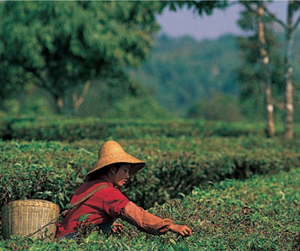
The Mekong river begins as a tiny thread up on the Tibetan plateau (maps don’t always agree about exactly where it rises) and then starts heading south. About fifty miles away, on either side, lie two other major Asian rivers—the Yangtze to the east and the Salween to the west—each separated from the Mekong by a steep ridge of mountains, as if a giant’s fingers had raked furrows in the hard rock for the rivers to follow. If you follow the course of the Yangtze, suddenly in northern Yunnan it makes a sharp bend, a huge bend, changes its mind it seems, and heads eastward, toward the South China Sea.
The Mekong and Salween keep heading south, rushing through their gorges toward Southeast Asia, flowing past tangled bamboo and dense jungle. They rise with the snow melt and the monsoon rains, then fall during dry season (November to April), leaving wide steep banks of sand and clay. The Salween soon heads into northern Burma; the Mekong continues to cut south through Yunnan, all the way to its southern tip. There the river valley is wider; there are villages up some of the side valleys, the surrounding hills are less craggy, and the climate is semitropical. The hills are terraced, growing rice and soybeans, tea farther up, and, near the high ridges, corn and root vegetables. On and over the ridges of hills that border the river live mostly tribal peoples: Shan, Akha, Wa, Mien, Hmong.
As the Mekong leaves China, the right bank of the river is Burma (the Shan State), and soon the left bank is Laos. In colonial times, this was also the border between the British and French colonial empires. Another hundred and twenty miles, and the river reaches the Golden Triangle near the ancient Thai town of Chiang Saen, where Burma, Laos, and Thailand meet. Nearby, the Kok River flows in from northern Thailand, bringing news of Chiang Rai and Tathon. There’s some river traffic on this stretch: A small boat full of fragrant apples from China is checked by Thai customs officials before being unloaded; little ferryboats take locals and tourists back and forth between Thailand and Laos; and cargo traffic from Huai Xai (Laos) heads down the river to central Laos.
For a short distance south of the Golden Triangle, the right bank is Thailand and the left Laos, but soon the river turns sharply east, leaving Thailand, and becomes wholly Lao. The Mekong is the central artery of Laos. It flows east through the forested mountains and grows as it’s joined by the Nam Ou and Nam Beng rivers flowing in from the north. At last it reaches the royal capital, Luang Prabang, with its goldspired temples, then turns due south again. By now the river is wide, navigable by flat-bottomed cargo boats except in the driest part of the dry season.
About a hundred and fifty miles south of Luang Prabang, it again turns hard left, east, and once more its right bank is Thailand. Here the landscape is scrubby and sometimes bone-dry, for Issaan (“northeast Thailand”) has poorer soil and less reliable rains than the north. On the left bank lies Vientiane, the capital of Laos and another of the historic city-kingdoms, along with Chiang Mai, Chiang Saen, Luang Prabang, Nan, Phayao, Chiang Rai, and Xieng Khuang, that once shared control of the central Mekong region. On either side of the river, children swim in the shallows, while women rinse off vegetables, fishermen tend their small wooden craft or mend nets, and, up on the sloping riverbanks, rows of leafy vegetables are carefully watered by hand every morning and evening. Another sixty miles east, and the river curves in a large bend to the right, south, heading past That Panom in Thailand and the Lao towns of Tha Khaek, Savannakhet, and, finally, Pakse, with its nearby Khmer ruins of Wat Phu. Then it takes a sharp jog east, away from Thailand. Soon after dropping over the Kone Falls, the river leaves Laos for Cambodia.
By now it’s very wide, especially in rainy season, home to freshwater dolphins, as well as many fish. In flood, it deposits the silt that makes Khmer rice fields productive, and it flows up into the Tonle Sap, the large fish-laden lake near the ruins of Angkor Wat. The Mekong is sluggish here, the landscape fairly flat, so the temples and the golden palace roof by the river in Phnom Penh are visible from far away. There’s the occasional steep-sided hill standing out from the flat alluvial landscape.
After Phnom Penh, it’s just a short distance through fertile farmland to the border with Vietnam. Here, for the first time, there’s a lot of life on and near the river, with towns like Chau Doc, Cantho, Sadec, Tra Vinh, and Vinh Long. But the Mekong is no longer a single river; it has split into two giant branches, each of them full-river–sized, that slowly flow, swollen with water and silt, through the rich, level lands of the Delta. Thousands of tiny channels and canals and water byways crisscross the Delta and it’s easy to be lost, for the flow of water is imperceptible—no way is clearly “downstream.” You have to ask a passing boatman, or pull over to a house and ask directions. There are fruit trees and mangrove swamps, slender arched footbridges over small canals, Khmer Buddhist temples and Cham mosques, Catholic churches, and Vietnamese and Chinese Buddhist temples, and wooden houses on stilts, and houseboats, and small boats that are home to whole families, and floating fish farms. Everywhere there are boats moving through the water: huge oceangoing cargo ships and tiny craft each rowed by a single man or woman standing up, big old ferryboats, and long narrow boats with powerful noisy motors transporting goods and people up and down and across the waterways.
Finally, near the sea, the land is less fertile, and the mosquitoes larger. Here the river has split into many more branches; it’s known as the River of the Nine Dragons, Song Cuu Long, all of them flowing into the sea. Here cargo ships and fishing boats head out onto the open ocean. From here, for many years, boatloads of refugees set out to chance their luck as they fled war, political uncertainty, and economic hardship. The silt in the river water stains the ocean as they meet, soil from Tibet, from Sichuan and Yunnan provinces, from the Shan State, Laos, Thailand, Cambodia, and Vietnam.

Starting in early spring in Yunnan, tea leaves are picked by hand from the bushes that grow in rows like a series of tidily trimmed hedges.
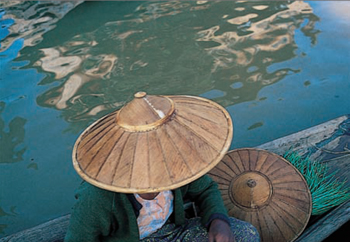
Boats become market stalls at the many floating markets in the Mekong region.
The people of Southeast Asia, like their food, are a complicated mix. Southeast Asia is one of the oldest inhabited regions in the world, and over a very long time, a great many different peoples have settled, conquered, and trickled into the region.
In Yunnan Province in China, the majority population is Han Chinese, though over a third of the total population is made up of people who are referred to in China as “minority peoples.” Officially, the Chinese government recognizes twenty-four different minority populations living in Yunnan Province; anthropologists say there are many more. These peoples—among them, the Dai, Akha, Hmong, Lahu, Lisu, and Bai—are an important part of the history and social fabric of the province, and of Southeast Asia in general. Groups of many of them have moved south into Burma, Laos, Thailand, and Vietnam, establishing villages both in river valleys and in the hills. There is also a significant Chinese Muslim population in Yunnan, the Hui, who are descendants of the powerful armies of Kublai Khan that swept through the province in 1253.
In Laos, in the Shan State, and in Thailand, one very large group stands out, and that is the Tai (sometimes referred to as Tai-Lao). The Tai were originally river valley people, rice cultivators (organized rice cultivation in the region perhaps began with the Tai), with strong and complex social and political structures. As a people, they may have originated in southern China or northern Vietnam. At some point in prehistory, groups of Tai moved into many parts of Southeast Asia, particularly along river valleys. Over time, as they moved into present-day Laos and Thailand, the Tai displaced and assimilated the previous peoples, the Mon-Khmer, who had hunted and farmed in the hills and valleys. The Tai established meuang, or agricultural townships. Some of these meuang, such as Chiang Mai, Luang Prabang, and Kengtung, became powerful principalities or kingdoms, like city-states.
Today, different branches of the Tai ethnographic family are found from the Red River Valley in northern Vietnam to the Brahmaputra Valley in northern Assam, along river valleys in Yunnan and Guangxi provinces in China, in Laos, and throughout northern, northeastern, and central Thailand. They include the Lao of Laos and northeast Thailand, the Shan (also known as Tai Yai, or greater Tai), the Tai Koen (whose capital Kengtung lies in the Shan State), the Tai Lu of southern Yunnan (known also as Dai), the Thai of central Thailand, the Tai Yuan of the Chiang Mai region, the Phuan in Xieng Khuang in eastern Laos, the Tai Dam (black Tai), who originated around Dien Bien Phu in Vietnam, and more.
All these groups speak different but related languages. Some use fish sauce, others salt. Some eat mostly jasmine rice; others, sticky rice. Most are Hinayana Buddhists, with a strong underpinning of animism, a belief in river and tree spirits. Their cultural similarities give the different cuisines in the region a strong underlying coherence.
The Khmer were one of the original or early peoples in Southeast Asia. They came into the region more than two thousand years ago, before the arrival of the Tai-Lao. The Khmer lived in the hills and river valleys along the Mekong and its tributaries, from the southern part of present-day Laos to the area around present-day Phnom Penh and downstream along the Mekong to the Delta, as well as west into present-day Thailand.
By the ninth century, the Khmer city-states in the region had taken shape as a Khmer kingdom known as Kambujadesa, the origin of both “Cambodia” and “Kampuchea.” It was centered at Angkor Wat, to the north of the Tonle Sap (Great Lake). Khmer civilization was complex and quite Indian-influenced: Khmer written and spoken language drew on Sanskrit and Pali, and the Khmer were first Hindu, then later Buddhist.
Over the following five centuries, the Khmer built cities and temples, both Hindu and Buddhist, throughout the region, from western Thailand to southern Vietnam. The ruins of an impressive Khmer city, Meuang Singh (Lion City), still stand near Kanchanaburi in western Thailand. Other Khmer ruins in the region date from the tenth to the thirteenth century, from Wat Phu in southern Laos to Phi Mai in northeast Thailand (Issaan) to the extraordinary remains at Angkor Wat and elsewhere in Cambodia. The Khmer also controlled all of what is now southern Vietnam, from Ho Chi Minh City south to the Delta, from the ninth to the seventeenth century, when they formally ceded it to the Vietnamese.
In the Mekong Delta, the Vietnamese are the majority population, but there are also large numbers of Khmer and Cham. The former are the descendants of the Khmer, for centuries the dominant population in the area, though some are more recent arrivals, fleeing the political instability and economic uncertainties of neighboring Cambodia. There are still very active Khmer temples in many towns in the Delta. The Cham are the Muslim descendants of the Indo-Malay people of Champa, the wealthy trading empire in the center of Vietnam, that was defeated by the Vietnamese in the fifteenth century. Cham people settled on both sides of the present Vietnamese-Cambodian border and also in the Cambodian province of Kampong Cham. Their villages are very distinctive, each built around a mosque, and alive with small herds of sheep and goats rather than the pigs found in non-Muslim villages.
The Vietnamese people originated in what is now northern Vietnam. They were ruled for almost a thousand years (until 938 of the modern era) by the Chinese, then became a tributary state of China. In the thirteenth century, the Vietnamese twice repelled invading Mongols led by Kublai Khan. In 1428, Le Loi, celebrated as a Vietnamese national hero, defeated the Chinese for the last time. He also defeated the Champa Empire, opening the way for Vietnamese expansion south. By 1802, with some help from the French, the Vietnamese controlled all of present-day Vietnam, which the Nguyen kings ruled from their capital in Hue.
The Vietnamese were historically Mahayana Buddhists, like the Chinese. Other religions also have large numbers of followers here, including Christianity (brought in by foreign missionaries over the centuries) and Cao Dai, a Vietnamese religion founded in the 1800s that is a distinctive synthesis of a number of religious systems.
Vietnamese culture and culinary influence in Southeast Asia extend beyond the borders of Vietnam. Because Vietnam was part of the colonial French empire and then a major player in the post-colonial wars in the region, from 1949 to 1975, there are sizeable Vietnamese communities in Cambodia, Laos, and northeast Thailand.

Vietnamese

Shan
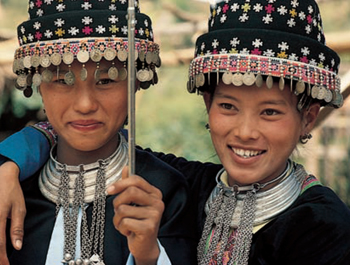
Hmong
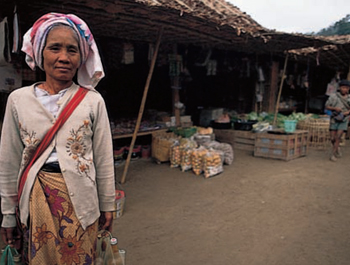
Karen
The foods of the Mekong region are as different, one cuisine from another, as Lebanese food is from Italian food, but just as we think of the Mediterranean as having a common palate, the same can be said for this part of Southeast Asia.
Here a good cook is constantly balancing and contrasting different tastes and textures. The basic palate is hot, sour, salty, sweet, and, sometimes, bitter. If you order a green papaya salad from a street vendor in Thailand, the last thing the vendor will do before serving the salad is to give you a small spoonful of the salad, asking for your opinion. If you’d like it hotter, more chiles will be added; if you want it saltier, more fish sauce; more sour, lime juice will be added; sweeter, more palm sugar.
And while this balancing act takes place in an individual dish like a green papaya salad, it also shapes a meal, determining what dishes should be served alongside others. One dish will be particularly hot, another leaning toward sour, another, salty. Dishes from different parts of the region can be served at the same meal, for they are all culinary cousins.
Texture and color are also critical in creating balance and contrast. Cool, fresh raw vegetables and herbs are used in abundance, essential not only for their taste but also for their texture and color. Fresh herb plates, lettuce, and leafy green vegetables are put out on the table to be used for wrapping, garnishing, and embellishing. A hot red curry will be served simply with rice, but alongside there will be a small plate of cucumber slices, and perhaps a small wedge of lime, there to be squeezed over the curry. Contrast and balance.
And, as in the Mediterranean, in the Mekong region there is a shared approach to food as well as a common palate. People are wildly eclectic in their tastes, proudly unrestrained. When you walk through a large open-air market, like Bangkok’s Weekend Market, or Thai Binh Market in Ho Chi Minh City, the diversity of the prepared foods for sale is mind-boggling, from the simple to the elaborate, from the plain to the exotic. There is little fear of food, there are few food rules, and there is virtually no hierarchy when it comes to food. Children are welcome in any restaurant, no matter how young they are or how in the way they might be. Food is for fun, for joy.
REGION BY REGION Yunnanese cooking is a distinctive regional Chinese cuisine, far from the culinary traditions of Beijing, Shanghai, and Guangzhou. It uses locally available foodstuffs and is strongly influenced by the culinary traditions of the non-Chinese cultures living in the area.
Hot chiles (dried and fresh), star anise, salty ham, and preserved cabbage are common ingredients and flavorings. Surprisingly little soy sauce is used; instead, salt is more important, used on its own or in combination with soy sauce. Easy stir-fries, leafy greens simply dressed, and lightly flavored soups are classic elements in Yunnanese home-style food. Condiments include Chinese pepper-salt (a blend of Sichuan pepper and salt; see page 309), chile pepper paste (la jiang; see page 27), and a dipping sauce for meat of dark vinegar and soy sauce. Though chiles, especially dried red chiles, are often used for flavor and heat, in general, Yunnanese Chinese food is not as chile-hot as the food of Sichuan or Hunan.
The minority peoples in Yunnan (see above) are primarily rice eaters, whose traditional meat is pork, grilled over an open fire or minced and flavored with hot chiles. In the southern tip of Yunnan, in the area known as Xishuanbanna, the majority culture is Dai, the large branch of the Tai ethnographic family also known as Tai Lu. Dai cuisine is very like northern Thai or Lao cooking in its use of grilled vegetables and flavorings. The staple rice is sticky rice, though jasmine rice is also eaten, and fish is an important food year-round. The Dai use salt for seasoning, not fish sauce.
Another thread in Yunnanese culinary tradition is Hui (Chinese Muslim). Because pork is forbidden in Hui households, the main meats used in cooking are sheep, goat, beef, and water buffalo. Hui cooks are famous in the region for their pickles and preserves, often made quite hot with dried red chiles. In a Hui restaurant, it is easy to be transported by smell and taste to Central Asia. Like the Uighur people in the Xinjiang region of western China, Hui cooks make tandoor-baked flatbreads as well as hand-cut wheat-flour noodles, accompanied by soupy dishes of stewed lamb or beef.
In Burma’s Shan State, and in Shan households in Thailand, food looks much like northern Thai food, but when you begin to smell and taste, it’s quite different. Salt, rather than fish sauce, is the staple seasoning. There is also a delicious seasoning base that is made with tua nao, dried fermented soybeans. It gives a wonderful nutty back-taste and depth to everyday dishes. The flavor balance is recognizably related to the Dai and the Lao; there is less sweet and more bitter and sour than in Thai cooking. Burmese influence is apparent in the occasional use of turmeric (see Chiang Mai Curry Noodles, page 134). The principal rice for Shan people is jasmine rice, not the sticky rice of northern Thais, although sticky rice is used to make sweets.
Like their northern Thai and Lao neighbors, the Shan have a large repertoire of easy, tasty, salsa-like dishes that depend on a flavor base of grilled garlic, shallots, and peppers (see, for example, Grilled Chile Salsa, Shan-Style, page 45). They call them nam prik, moist spicy dishes to eat with rice, closely related to the Lao dishes known as jaew. The Shan also use a distinctive slow-cooking method to produce a class of dishes known as oop, in which flavors blend as the ingredients cook in a tightly covered pot over low heat (see, for example, The Best Eggplant Dish Ever, page 159).
Until the nineteenth century, northern Thailand was made up of a number of separate sovereign kingdoms, the most powerful being centered in Chiang Mai. (The others included Nan, Chiang Rai, Phayao, and Chiang Saen.) The written and spoken language in the north was different from that of central Thailand. Over the last hundred and fifty years, as the northern kingdoms have been absorbed into Thailand, these regional differences have become less apparent, though northerners still speak their dialect and are proud of their distinctive culture and history.
Geography and history have significantly influenced the food and cooking of northern Thailand. The north is mountainous and has a more extreme climate than the central plains: Winters are much cooler (occasionally there’s a mild frost in the high mountains) and in the dry season and rainy season, temperatures are higher than in Bangkok. Coconuts do not thrive here and relatively little fish is eaten. Because of its strategic location, bordered by Burma and Laos, and just downriver from China, northern Thailand is a culinary crossroads, where Shan and northern Thai and Lao cultures mix together in a distinctive cosmopolitan blend.
Northern Thai cuisine relies on beef and water buffalo, as well as pork (see, for example, Spicy Northern Sausage, page 256, and Northern Rice Noodle Stew, page 140). Flavors tend to the hot and sour, far from the sweet coconut-milk richness of Bangkok food. Rendered pork fat is the traditional cooking oil, and pork cracklings a much-loved snack for scooping up spicy salsas and dips. Sticky rice is the staple rice, though jasmine rice is now widely available. Like the Lao and the Shan, northern Thais have a repertoire of salsas that start with a base of grilled garlic, shallots, and chiles and proceed creatively from there.
In northeast Thailand (Issaan), there is much more of a grassroots feel to the food. Most people are Lao and share a spoken language and a culinary approach with the lowland people of Laos. The land and climate of Issaan are by far the most unrewarding in Thailand. Drought has forever been a problem, as have relatively poor soil. Ingredients that can be gathered from the wild, like bamboo shoots, mushrooms, and various roots and leaves, are important to people who cannot rely on good crops. Fish from the Mekong and its tributaries is also an important staple, eaten fresh or dried, or salted and fermented to produce fish sauce and fish paste.
Northeastern cooking is direct and forceful. It’s often chile-hot and always inventive. From spiced beef jerky to skewers of grilled chicken to fish rubbed with a paste of coriander root and black pepper and then roasted in a banana leaf, to eat Issaan food is to taste the rural roots of the cuisine. What comes through strongly is a sense of cooks being forced by adversity into ingenious solutions. Who else would think to roast raw rice with aromatics, then grind it to make a condiment powder? (See Aromatic Roasted Rice Powder, page 309.) Issaan food has long been our favorite food in the Thai repertoire: We love the grilled meats and sticky rice, the jerkys and laab and the strong earthy salsas. It’s all saep—delicious!
Fish fresh-caught from rivers, lakes, and village ponds are grilled, curried, fried, steamed, or sun-dried for longer storage, or packed in salt and fermented to make fish sauce.
Pumpkins and squash are eaten in curries and soups and are a standard part of the STEAMED VEGETABLE PLATE (page 69) of the Shan, Lao, and northern, Thai tables.
In Lao villages and towns, the food resembles that of Issaan, but with some pronounced regional differences north to south. Sin khouai, or water buffalo meat, is common, and so, surprisingly to us, are turkeys. In the remote and mountainous areas, there are more tribal people than there are in lowland Lao; the rural markets are full of leaves and roots and shoots gathered in the wild, and hunters sell small animals and birds that they have snared or shot in the jungle. In every market, large or small, there are also river frogs, eels, fresh-caught fish, a wide variety of leaves and herbs, and piles of river weed for sale, all gathered locally. It’s a reminder of how large, wild, and relatively unpopulated Laos is: fewer than five million people in a country half the size of Thailand (with nearly sixty million people).
In many ways, Laos feels the way Issaan and north Thailand must have felt before about 1950. Older people from Thailand, traveling to Laos, frequently remark that Lao food markets remind them of Thailand forty or fifty years ago, “the old ways.”
The most distinctive regional cuisine in Laos is centered in Luang Prabang. Here flavors tend decidedly toward bitter, especially in simmered dishes such as oaw’ moo (see Luang Prabang Pork Stew with Bitter Greens, page 245). Farther south, in Vientiane, the cuisine is more like that of Issaan, with grilled fish and chicken, stacks of sausages, thick spicy salsas, and marinated dried meats. In both regions, leaf-wrapped snacks, called miang, are a favorite street food (see Green-Wrapped Flavor Bundles, page 269). Some Vietnamese presence is visible in the food in major towns: Market vendors include people selling Vietnamese noodle soups (known as foe in Vientiane), grilled pork balls (nem nuong; see page 252), Saigon Subs (page 287), and crispy Vietnamese crepes (banh xeo; see page 280).
One of the best reasons to travel to Laos is to taste Lao sticky rice. It’s less polished than the Thai sticky rice that’s commercially available, and hence has more of a grain taste. It is the daily staple, especially in villages and small towns.
Khmer (or Cambodian) home-style cooking, like all food and cooking in Southeast Asia, is based on dishes to eat with rice—not sticky rice, but aromatic jasmine rice. Rice noodles are an important staple, and so is fish. Fresh fish is grilled or curried or stir-fried, and, like the people of Thailand, Laos, and Vietnam, Khmers use fish sauce (tuk traey in Khmer) and fermented fish paste (prahok) to season and flavor their food. Though Khmer cuisine has no strong vegetarian tradition (unlike Vietnamese and Chinese), meat and fish are eaten only in moderation, with plenty of herbs and cooked and fresh vegetables, and always as an accompaniment to rice or noodles.
Tastes tend to be milder than in Issaan cooking, with less fiery heat. There’s less sweet in the flavor balance than in southern Vietnamese food and more sour and acid citrus flavors. In the markets, the heaps of thinly sliced lemongrass, with women busy slicing more as you pass by, and the stacks of galangal and ginger for sale are surprising at first sight, and give a vivid idea of what a large role these distinctive flavors play in the cuisine. As in Thailand, galangal flavors most curry pastes; ginger is often used as a vegetable in stir-fries, huge handfuls of it, rather than just as a flavoring (see Khmer Stir-fried Ginger and Beef, page 219). Curry pastes are made fresh, pounded and ground in a stone mortar; they often have a distinctively strong lemongrass note. Curries are simmered or steamed and are rich with coconut milk (for example, Khmer Chicken Samla’ with Coconut Milk, page 204). It’s all very tropical and aromatic compared to northern Thailand or Yunnan.
French colonial rule, from the 1880s until the 1950s, had a lasting impact on Cambodian food, as it did on Vietnamese, at least in the cities and towns. In the cities, French-style bread is still sold in the mornings and is also used to make sandwiches (see Mekong Subs, page 284); butter found its way into some dishes; and meat eating, especially of beef or water buffalo, increased among those who could afford it. Coffee, cultivated in Cambodia, Laos, and Vietnam, is common in the cities.
In Vietnam’s Mekong Delta region and in nearby Ho Chi Minh City (formerly Saigon), as in the rest of Vietnam, the standard eating implements are chopsticks (south of China, everywhere else in the Mekong region, people eat either with their hands or with a spoon and fork, except when eating noodles). Noodles and noodle soups are common, and the regional version of noodle soup is called hu tieu, very like the Khmer name for noodle soup, ktieu. The local version of xoi, a breakfast of sticky rice steamed with mung beans or nuts, is lush with coconut milk and adorned with fresh herbs and strong flavors (see page 98), whereas in northern Vietnam, it’s a very simple steamed rice with beans or peanuts. Mekong river fish, freshly caught or from one of the many fish farms that operate from floating platforms in the river, are on sale at every market. Snake is popular, and so, at some times of year, are snails.
Fresh herbs and greens in the form of a salad plate and garnishes are important flavorings and ingredients at almost every meal. Local specialties include sour soup, a close cousin of the Thai tom yum, and a class of slow-cooked sweet and salty dishes known as ko tieu (see Slow-Cooked Sweet and Spicy Fish, page 191). The Vietnamese genius for combining fresh and cooked ingredients is evident in fresh rice paper–wrapped rolls (see Rice Paper Roll-ups with Shrimp and Herbs, page 177, and Vietnamese Grilled Pork Balls, page 252).
In this tropical climate with its abundant supply of water, the fruit is fabulous, abundant, and varied. There are lichees and longans and mangoes and rambutans, flavorful avocados, and exotic-looking bright pink fruits known in English as “dragon’s eye.” The Delta, Cantho in particular, is also known for its sweet snacks.
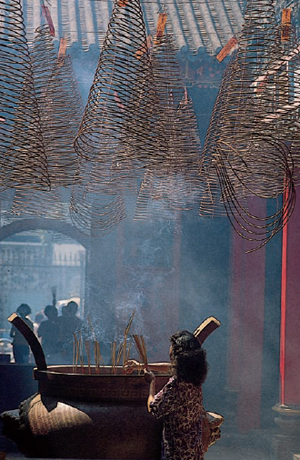
Buddhism is the dominant religion of the Mekong region, though there are also Muslims, Christians, animists, and followers of Cao Dai. Huge coils of incense burn as an offering at a temple in Cholon, the Chinese district of Ho Chi Minh City.